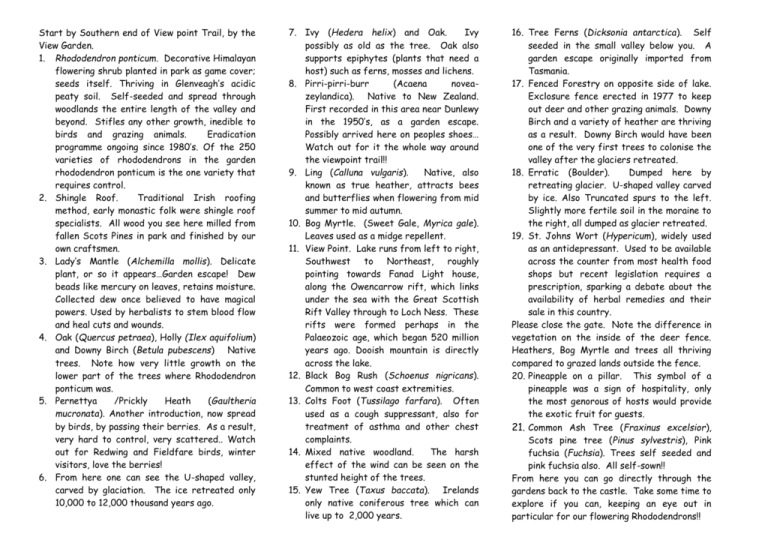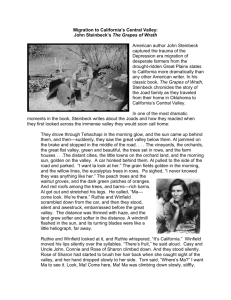Start by Southern end of View point Trail, by the View Garden
advertisement

Start by Southern end of View point Trail, by the View Garden. 1. Rhododendron ponticum. Decorative Himalayan flowering shrub planted in park as game cover; seeds itself. Thriving in Glenveagh’s acidic peaty soil. Self-seeded and spread through woodlands the entire length of the valley and beyond. Stifles any other growth, inedible to birds and grazing animals. Eradication programme ongoing since 1980’s. Of the 250 varieties of rhododendrons in the garden rhododendron ponticum is the one variety that requires control. 2. Shingle Roof. Traditional Irish roofing method, early monastic folk were shingle roof specialists. All wood you see here milled from fallen Scots Pines in park and finished by our own craftsmen. 3. Lady’s Mantle (Alchemilla mollis). Delicate plant, or so it appears…Garden escape! Dew beads like mercury on leaves, retains moisture. Collected dew once believed to have magical powers. Used by herbalists to stem blood flow and heal cuts and wounds. 4. Oak (Quercus petraea), Holly (Ilex aquifolium) and Downy Birch (Betula pubescens) Native trees. Note how very little growth on the lower part of the trees where Rhododendron ponticum was. 5. Pernettya /Prickly Heath (Gaultheria mucronata). Another introduction, now spread by birds, by passing their berries. As a result, very hard to control, very scattered.. Watch out for Redwing and Fieldfare birds, winter visitors, love the berries! 6. From here one can see the U-shaped valley, carved by glaciation. The ice retreated only 10,000 to 12,000 thousand years ago. 7. Ivy (Hedera helix) and Oak. Ivy possibly as old as the tree. Oak also supports epiphytes (plants that need a host) such as ferns, mosses and lichens. 8. Pirri-pirri-burr (Acaena noveazeylandica). Native to New Zealand. First recorded in this area near Dunlewy in the 1950’s, as a garden escape. Possibly arrived here on peoples shoes… Watch out for it the whole way around the viewpoint trail!! 9. Ling (Calluna vulgaris). Native, also known as true heather, attracts bees and butterflies when flowering from mid summer to mid autumn. 10. Bog Myrtle. (Sweet Gale, Myrica gale). Leaves used as a midge repellent. 11. View Point. Lake runs from left to right, Southwest to Northeast, roughly pointing towards Fanad Light house, along the Owencarrow rift, which links under the sea with the Great Scottish Rift Valley through to Loch Ness. These rifts were formed perhaps in the Palaeozoic age, which began 520 million years ago. Dooish mountain is directly across the lake. 12. Black Bog Rush (Schoenus nigricans). Common to west coast extremities. 13. Colts Foot (Tussilago farfara). Often used as a cough suppressant, also for treatment of asthma and other chest complaints. 14. Mixed native woodland. The harsh effect of the wind can be seen on the stunted height of the trees. 15. Yew Tree (Taxus baccata). Irelands only native coniferous tree which can live up to 2,000 years. 16. Tree Ferns (Dicksonia antarctica). Self seeded in the small valley below you. A garden escape originally imported from Tasmania. 17. Fenced Forestry on opposite side of lake. Exclosure fence erected in 1977 to keep out deer and other grazing animals. Downy Birch and a variety of heather are thriving as a result. Downy Birch would have been one of the very first trees to colonise the valley after the glaciers retreated. 18. Erratic (Boulder). Dumped here by retreating glacier. U-shaped valley carved by ice. Also Truncated spurs to the left. Slightly more fertile soil in the moraine to the right, all dumped as glacier retreated. 19. St. Johns Wort (Hypericum), widely used as an antidepressant. Used to be available across the counter from most health food shops but recent legislation requires a prescription, sparking a debate about the availability of herbal remedies and their sale in this country. Please close the gate. Note the difference in vegetation on the inside of the deer fence. Heathers, Bog Myrtle and trees all thriving compared to grazed lands outside the fence. 20. Pineapple on a pillar. This symbol of a pineapple was a sign of hospitality, only the most genorous of hosts would provide the exotic fruit for guests. 21. Common Ash Tree (Fraxinus excelsior), Scots pine tree (Pinus sylvestris), Pink fuchsia (Fuchsia). Trees self seeded and pink fuchsia also. All self-sown!! From here you can go directly through the gardens back to the castle. Take some time to explore if you can, keeping an eye out in particular for our flowering Rhododendrons!!









